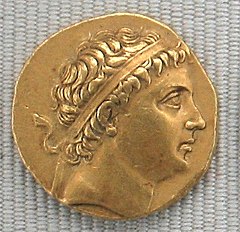Diodotos I
 | |
| król greko-baktryjski | |
| Okres | od ~250 p.n.e. |
|---|---|
| Następca | |
| Dane biograficzne | |
| Data śmierci | |
| Dzieci | |
| Moneta | |
(c) Classical Numismatic Group, Inc. http://www.cngcoins.com, CC BY-SA 2.5 | |
Diodotos I – satrapa Baktrii z ramienia Seleucydów w połowie III w. p.n.e., po uniezależnieniu się założył królestwo Greko-Baktryjskie.
Dokładna data rewolty Diodotosa przeciwko Selucydom jest kwestią sporną, i u poszczególnych historyków waha się pomiędzy 256 p.n.e. a 239 p.n.e. Aktualnie jednak większość uczonych umiejscawia ją około 250 p.n.e. Oprócz mało wiarygodnych źródeł klasycznych znamy Diodotosa głównie z jego monet. Dzielą się one wyraźnie na trzy grupy. Do pierwszej należą monety bite w imieniu Antiocha II, z jego portretem na awersie i Apollem (bóstwem opiekuńczym dynastii Seleucydów) na rewersie. Na drugiej z nich, pozostawiając imię swojego suwerena, Diodotos zastąpił portret Antiocha II swoim, a przedstawienie Apolla na rewersie przedstawieniem Zeusa. W ten sposób Diodotos podkreślił swoje pretensje do niezależności, nie zrywając ostatecznie z Seleucydami. Na trzeciej grupie monet również imię Seleukidy jest zastąpione imieniem Diodotosa, co oznacza jego pełną niezależność. Stało się to gdzieś około 239 p.n.e./238 p.n.e. Niedługo potem Diodotos zmarł, pozostawiając władzę swojemu synowi Diodotosowi II.
Bibliografia
- Osmund Bopearachchi: Diodotus. Encyclopædia Iranica. [dostęp 2010-06-20]. (ang.).
- Stanisław Kalita, Grecy w Baktrii i w Indiach. Wybrane problemy ich historii, Edward Dąbrowa (oprac.), Kraków: Towarzystwo Wydawnicze „Historia Iagellonica”, 2005, ISBN 83-88737-92-9, OCLC 749696923.
Media użyte na tej stronie
Autor: unknown, Licencja: CC BY-SA 3.0
Obverse of old coin of Diodotus I of Bactria wearing the diadem, c. 245 BCE. Cabinet des Medailles. Personal photograph 2006.
(c) Classical Numismatic Group, Inc. http://www.cngcoins.com, CC BY-SA 2.5
Greek Kings of Bactria. Diodotus I, in the name of Antiochos II of Syria. Circa 255-235 BC.
- AV Stater (8.27 gm). Attic standard. Mint A (near Aï Khanoum).
- Diademed head of Diodotos I right
- ΒΑΣΙΛΕΩΣ ΑΝΤΙΟΧΟΥ, Zeus advancing left, holding thunderbolt in right hand, aegis draped over extended left arm, eagle at his feet standing left; N in left field.
- AV Stater (8.27 gm). Attic standard. Mint A (near Aï Khanoum).
- Cf. Holt Series A, Group 7 (tetradrachm); Bopearachchi -; SNG ANS -; cf. MIG 63 (for type); SC 629. :Superb EF, rare without test cut.
- SECTION INTRO
- The following group of Bactrian gold staters almost certainly comes from a hoard found in India in 2001. Initially thought to number in the many hundreds, current opinion places the count at about 70 pieces. For background in the circumstances surrounding the hoard, see O. Bopearachchi and K. Grigo, "Thundering Zeus revisited," in ONS Newsletter 169 (Autumn 2001).
- The variety of Diodotus I gold stater with the N control, as in lots 684-7, was previously known only from a cast forgery in the BM, although the control was known for tetradrachms. It was thus excluded in the catalogs by Holt (Thundering Zeus) and Kritt (Dynastic Transitions in the Coinage of Bactria). The many new examples from the hoard now firmly establish the validity of this variety, and it has been published as SC 629. The variety with wreath and M controls (lot 692) is apparently new and unpublished. It is from the same Mint A as the other hoard coins, and should probably be placed between the N variety (Holt A7, cf. Dynastic Transitions, p. 8) and the wreath variety (lots 688-691; Holt A8).
- Other implications for the current model of Diodotid coinages will follow from still additional unpublished varieties from the hoard in due course. Holt had proposed a theory to explain the numerous test cuts on these coins (cf. Dynastic Transitions, pg. 14), relating them to a weight reduction from 8.6 gm to circa 8.3 gm during the reign of Diodotos II at the time of the invasion of Euthydemos. With numerous uncut Diodotos I staters from the hoard at the lower weight, such as lots 684 and 688, this theory must now be discarded. The near uniform placement of the test cuts does suggest some official act however.
- The presence of such a major hoard of Bactrian gold in India strongly supports substantial contacts between the Seleucid colonists and that area, and likely also the presence of an Indian component of the Seleukid colony at Aï Khanoum, as developed in Dynastic Transitions (cf. pp. 67-68 and 177-178).
- Brian Kritt


